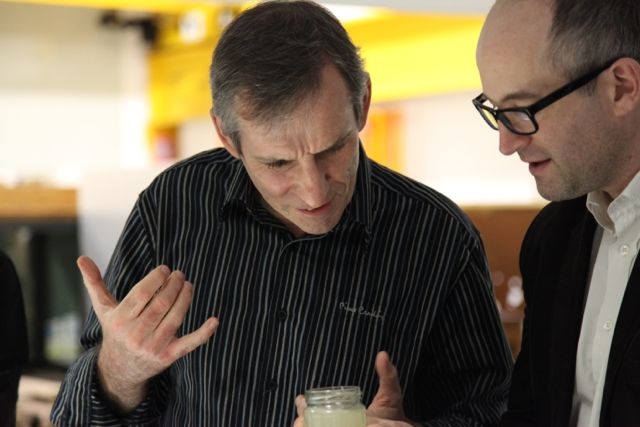Materials at the Centre
30 April 2013

Our first research workshop at UCL brought together researchers from across the arts and humanities, social and historical sciences and physical sciences to interrogate the relationship between academic research and materials and making.
Our three directors, Mark Miodownik, Martin Conreen and Zoe Laughlin, kicked off the workshop and welcomed everyone to the newly-opened Institute of Making. Starting from the principle that materials, the act of making and processes of experimentation can fire the imagination in ways that compliment language and make possible new ways of thinking, the day involved a mix of demonstrations, discussions and making tasks.
English professor Steven Connor set the tone for the day with a performative keynote speech in which he shared his new theory of the ‘senstance’ whilst performing a hand-washing ritual, working up a soapy lather on stage. Connor riffed about our fascination with particular substances and emotional reactions to them: the fetishisation of the rustle of silk and creak of leather and phobias of the spilling of salt and the sensation of sugar crunching underfoot. He explored the history of soap, and the way in which our experience of its frothiness is the result of the coming together and co-mingling of oils and greases, skin cells, hands and the act of rubbing and abrasion. He finished with a discussion of the intermingling of substance and subject evident in Herman Melville’s description of labourers’ hands in a slimy bath of ambergris.
Now in an appropriately substance and sensation-oriented frame of mind, we then segued into a hands-on session that took place around the MakeSpace. Participants split up into groups and got involved in conversations with three groups of researchers. Geoarchaeologist Ruth Siddall put pigments under the microscope: participants brought their cosmetic products with them for analysis, and Ruth identified the waxy base materials and shiny micas and minerals in our eyeshadows and foundations. She discussed her own vast and wonderful collection of pigments used in works of art from the Bronze Age to the present day. Sculptor Anja Borowicz made oil pastels with her group and talked about her use of powdered clay in her work, its uses as an artistic and industrial medium, and its semantic associations. Engineers Maria Nelson and Helene Jones demonstrate the principles of bio-compatible scaffolding using 3D printed dissolvable PVA structures, inks and woven fibres.
Over tea, artist Hermione Allsopp and Lecturer in Information Studies Anne Welsh drew our attention to the Materials Library and invited guests to pick out and group their favourite objects and discuss their materials classificatory systems. Sculptor Hiroko Nakajima showed her sensory silicone sculptures talked about her materials experiments.
After lunch, conservation scientist/art historian duo Emma Richardson and Petra Lange-Berndt added to the frothy and foamy feeling of the day by mixing up a basin full of expanding polyurethane foam that effervesced whilst they discussed plastic materials in art, their unpredictability, and the effects that their properties have on the reception, interpretation and conservation of works of art. They brought numerous samples of these plastics from their own collections to pass round to participants.
In the final presentation of the afternoon, historian of science Simon Werrett discussed how lodestones, red inks and adhesives fired the early modern imagination, exploring how materials are intimately connected to the history of science. He put forward some suggestions for how we might interrogate early scientists’ relationships with materials, including the possibility of restaging old experiments from physics and alchemy at UCL.
Science writer Philip Ball reflected on the day, kicking off a lively discussion between the array of geographers, engineers and anthropologists in the group about the academic study of materials properties, craft, and the role of making in research.